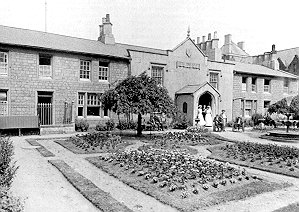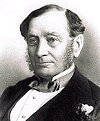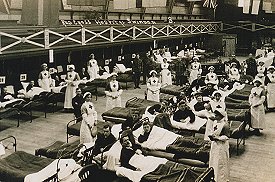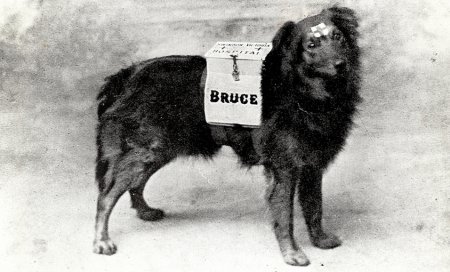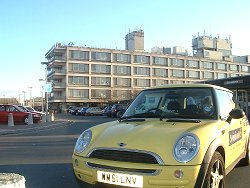Bed pans and begging dogs!
NHS75: A look back at Swindon's blueprint for the National Health Service
Describing Swindon as the 'birthplace' of the NHS is perhaps not entirely accurate.
Where Swindon led, the rest of the country indeed followed - but not until a century later.
It was no wonder that Minister of Health Aneurin Bevan turned to Swindon for inspiration when he needed a model for the complex business of founding the NHS in the mid-1940s. Here he found a community already served by its own local service in a town where generations of Swindon people had come to expect health care as a birthright. The development of this revolutionary attitude to health care can be traced right back to Sir Daniel Gooch, the first locomotive superintendent of the GWR at Swindon, whose responsiblities went far beyond railway engineering.
Ever mindful of the monster he had created, Gooch took his social responsibilities seriously and was quick to ensure that despite the routinely harsh conditions endured by industrial workers of the period, at Swindon they did not become impossible. The plight of Swindon's new workforce became apparent only a matter of months after the foundation stone was laid for the railway works, but Gooch acted quickly. The combination of economic depression and a high rate of accidents at the works in the mid-1840s was enough to appeal to the directors of the GWR to not only appoint a works doctor but also to secure him free lodgings in company property. Gooch later wrote: "While I strove to do my duty I remembered that the moral welfare of those under me was a thing for which I would have to answer at a higher tribunal. The happiness of my men and their families depended much upon the influence I exerted over them, and I have striven to make the influence beneficial." Gooch found plenty of like-minded people in Swindon who were determined to make conditions tolerable and they did not stop at the provision of a company doctor. In December 1847 the Medical Fund Society was founded. It was a world first. Swindon Works became the only industrial organisation in the world that required membership of a medical fund as a condition of employment. Gooch's successor was Joseph Armstrong and as another true champion of the men who worked for him, he took his social responsibilities even more seriously than Gooch. The Medical Fund went from strength to strength.
In addition, a substantial new house and surgery for the company's chief medical officer was built in 1876. Called Park House because it overlooked Faringdon Road Park, this building was to be familiar to generations of railway employees who were to have their medicals there before joining the company. The work of the Medical Fund knew few bounds. In 1878 it began providing artificial limbs - made by craftsmen from the carriage and wagon works - and nine years later opened its first dental surgery, the dentist removing over 2,000 teeth in his first few months in his new post.
The Medical Fund continued to be a major issue for the ever-expanding railway town and when facilities became inadequate in the late 1890s, plans to expand the service were put into effect. The result was impressive consulting rooms, a dispensary and new swimming baths at Milton Road, which opened in 1892, almost opposite the cottage hospital. The building and many internal features including the swimming baths, still survive today as The Health Hydro. The baths were the last major building erected by the GWR outside the works and responsbility from then on passed to the local authority. When the founders of the NHS adopted the catchphrase of 'cradle to grave' to describe the scope of the service they wanted, they found that Swindon had already long since established such a service - and quite literally. As early as 1887, the GWR had even appointed a works undertaker, complete with horse-drawn hearse and nodding black plumes. All this was provided free to members. The first calls for a National Health Service were not heard until 1909 and not answered until over 30 years later. Swindon must have been wondering why it didn't happen sooner. A hundred years and six months after Swindon had its embryonic health service through the Medical Fund, the NHS, at last, was born.
Swindon's NHS Trail
In 1998 the National Health Service celebrated its 50th anniversary. As part of the celebrations, an NHS Heritage Trail was created in Swindon to acknowledge the town's role in the development of the National Health Service. This section follows the same trail to tell another proud story from Swindon's Heritage.
Medical Fund Hospital, Faringdon Road The former Medical Fund Hospital was something of a social revolution when it was built in 1871, complete with a single ward containing five beds. Yet it was a natural result of the thriving Medical Fund Society that had been formed in 1871.
The building was formerly the armoury of the XI Wiltshire Volunteer Rifle Corps and conversion to a hospital cost £130. This was borne by the GWR, who also converted one adjoining cottage into nurses' quarters and another into a dispensary and consulting room. The dispensary had to cope with an average of 700 visitors a day in the winter months.
It should be noted that Sir Daniel Gooch, by then chairman of the company, also donated £1,000 to help fund the hospital. A 'temporary' new wing was added in 1927 and remained in use until the hospital closed in 1960. This has now been demolished. The hospital was made obsolete by the building of the new Princess Margaret Hospital, but today it still serves Swindon people, but in a different capacity - as the Central Community Centre.
Victoria Hospital The Victoria Hospital was Swindon's first general hospital and dates from 1887, the year of Queen Victoria's golden jubilee - and hence the name.
A hospital best remembered by many for 'Bruce', the begging dog, who used to raise funds for the Victoria with his money box during Edwardian times.
The Victoria closed in 2008 and is currently being re-developed as flats (see picture gallery below).
Former GWR Museum, Faringdon Road
The building was once a workers' hostel which was called the Barracks - and then a Methodist Chapel, but it served as the town's Great Western Railway Museum from 1960. On 3 October 1999, the old museum closed its doors to the public - to be replaced by the prestigious new STEAM Musuem. Next door, one of the railway village cottages has been restored, giving visitors a fascinating insight into the ordinary lives of the railway workers.
More about the Railway Village Museum Health Centre, Carfax Street In contrast to some of the historic venues on the rest of the tour, the Health Centre is an example of the more modern approach to health care in Swindon in the 1990s. The Hospital That Never Was As early as 1930, Swindon was to have a brand new hospital to replace the original Medical Fund Hospital which opened nearly 60 years before. It was to have 80 beds on four floors and would feature modern innovations like X-ray facilities. Plans were passed and artists' impressions made, but the worldwide implications of the Wall Street Crash of 1929 meant that Swindon was to wait until 1960 for its new hospital.
Princess Margaret Hospital, Okus Road
It was appropriate that the first purpose-built hospital funded by the National Health Service in this country should be in Swindon.
The town's new hospital, laid out on a 20-acre site, was begun in 1957 and named after Princess Margaret who laid the foundation stone.
It was opened for business in 1960 with 800 beds. Two years later a School of Nursing was added, quickly followed by other extensions.
It closed in 2002, with all departments transferred to the Great Western.
Swimming Baths, Milton Road
The large 'swimming baths' sign on the front of the building at Milton Road only told part of the story when the building opened in 1891. In fact, the building housed something of a health and leisure complex which was far in advance of most other workers' facilities in other industrial towns. There were not one but two swimming baths, plus turkish baths, washing baths, a dispensary and a suite of consulting rooms. Today the building still helps to keep Swindon people healthy having been turned into Swindon Borough Council's Health Hydro.
Mechanics' Institute, Emlyn Square The history of the now neglected Mechanics Institute goes arm-in-arm with that of the Medical Fund Society. Together they provided for both the educational development and the medical welfare of ordinary working people in Swindon on a scale unheard of in any other industrial centre in the world. NMRC, Kemble Drive It is an honour for Swindon that it hosts the National Monuments Records Centre and rather fitting that it should occupy the former offices of the GWR's chief mechanical engineers and the works' drawing offices. The centre's governing body, The Royal Commission on the Historical Monuments of England, gave Swindon a lasting reminder of its heritage with the publication of a defintive book, Swindon: The Legacy of a Railway Town, which was published in 1995.
A Footnote for a Nameplate
When Swindon got its first hospital in 1871, the town missed a good opportunity to honour Sir Daniel Gooch by naming it after him. After all, it was Gooch who set the wheels in motion for the whole programme of health care in Swindon.
The same mistake has been made with every subsequent hospital in the town, albeit the GP surgery in Carfax Street named the Daniel Gooch Practice after the man himself.
Now, as Swindon enters a new era with the Great Western as its flagship hospital, perhaps those charged with the responsibility for naming the building will right the previous wrongs and put Gooch's name over the door where it belongs. |
|
||||||||
|
||||||||
|
||||||||
|
||||||||
|
||||||||
|
||||||||
|
||||||||
|
||||||||
|
||||||||
|
||||||||
|
||||||||
|
||||||||
|
||||||||
|
||||||||
|
||||||||
|
||||||||
| Follow Swindon's NHS Trail | ||||||||





